 W
WAcanthodes is an extinct genus of spiny shark. Fossils have been found in Europe, North America, and Australia.
 W
WThe arrow goby is a species of goby native to marine and brackish waters of the Pacific coast of North America from British Columbia to Baja California. This species grows to a length of 6.4 centimetres (2.5 in) SL, though most do not exceed 4.2 centimetres (1.7 in) TL. This fish can also be found displayed in public aquaria. This species is the only known member of its genus.
 W
WChromidotilapia guntheri, or Günther's mouthbrooder, is a cichlid from Africa. It was previously considered to consist of two subspecies, the common C. g. guntheri ranges from Liberia to Equatorial Guinea and Niger, and the critically endangered C. g. loennbergi which was thought to be restricted to Lake Barombi-ba-Kotto, a small crater lake in Cameroon but these subspecies are not supported by subsequent authorities. The species is noted for being a biparental mouthbrooder. Eggs are laid on a flat open surface and taken in the parents' mouth. Unlike many mouthbrooding cichlid species, both parents participate in the mouthbrooding.
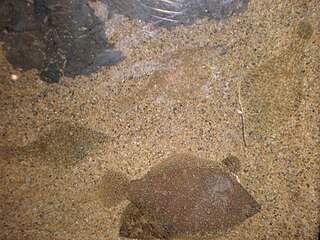 W
WCitharichthys stigmaeus, the speckled sanddab, is a species of flounder in the genus Citharichthys. It is native to the eastern Pacific Ocean, ranging from Alaska in the north to Baja California, Mexico in the south.
 W
WThe cocinero, also known as the barred jack and striped jack, is a species of small marine fish classified in the jack family, Carangidae. The cocinero is distributed through the tropical eastern Pacific Ocean, ranging along the west American coastline from Baja California in the north to Peru in the south. It is a pelagic species, inhabiting the upper water column in both coastal and offshore oceanic waters, occasionally making its way into estuaries. The species may be identified by its colouration, having 8 or 9 incomplete dark vertical stripes on its sides, with scute and gill raker counts also diagnostic. It is small compared to most other species of Caranx, reaching a length of 37 cm in total. The cocinero is a predatory fish, taking small fishes, crustaceans, and various benthic invertebrates in shallower waters. Little is known of the species' reproductive habits. The cocinero is of moderate importance to fisheries along the west coast of South America, and the species has been used in aquaculture trials. It is taken by various netting methods and by spear, and is sold fresh, dried, and salted at market.
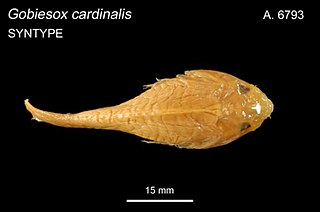 W
WCreocele cardinalis, the broad clingfish, is a species of clingfish found on the southern coast of Australia.
 W
WCynoglossus canariensis, commonly known as the Canary tonguesole is a species of tonguefish. It is commonly found in the eastern Atlantic Ocean off western Africa, from Mauritania and Western Sahara south to Angola, including the Canary Islands and Cape Verde Islands. It is a demersal species found at depths of 10-300m, it has been found in brackish water, but is normally a coastal species which occurs over substrates of sand or mud. It feeds on small fish and crustaceans. This species is targeted in trawl fisheries throughout its range and in many areas, it appears to have undergone significant declines. For example, in Gabon the mixed Cynoglossus stock is considered overexploited, while in other parts of western Africa such as Mauritania the stocks of Cynoglossus had declined by over 60% in the five or six years up to 2015. The IUCN list C. canariensis as Near Threatened due to is dependence on conservation.
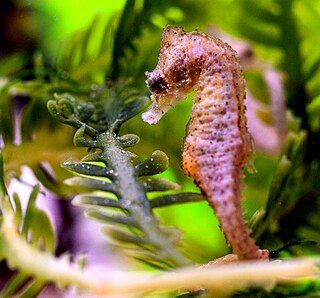 W
WThe dwarf seahorse is a species of seahorse found in the subtidal aquatic beds of the Bahamas and parts of the United States. It is threatened by habitat loss. According to Guinness World Records, it is the slowest-moving fish, with a top speed of about 5 feet (1.5 m) per hour.
 W
WEnneanectes carminalis, known commonly as the carmine triplefin or the delicate triplefin in Mexico and the United Kingdom, is a species of triplefin blenny. It is a tropical blenny known from reefs from Mexico to Panama, in the eastern central Pacific Ocean. It was originally described by D.S. Jordan and C.H. Gilbert in 1882, as Tripterygium carminale. Blennies in this species can reach a maximum length of 3 centimetres, and feed primarily off of benthic algae and invertebrates.
 W
WThe Gulf flounder is a species of saltwater flounder.
 W
WHemigrammus ocellifer is a South American freshwater fish, also described by the synonyms Hemibrycon ocellifer and Tetragonopterus ocellifer. Common names include beacon fish, beacon tetra, head-and-tail light tetra and head-and-taillight tetra. It is found in the rivers of Guyana, Suriname, French Guiana, and the Amazon Basin of Brazil and Peru.
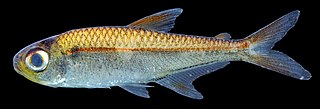 W
WHemigrammus elegans is a species of freshwater fish in the family Characidae native to South America. The type locality is Óbidos, Amazon River, Brazil.
 W
WHypoplectrus gemma, the blue hamlet, is a species of marine ray-finned fish, a sea bass from the subfamily Serraninae which is part of the family Serranidae, which also includes the groupers and anthias. It is found in the western Atlantic Ocean and occasionally makes its way into the aquarium trade.
 W
WHypsoblennius ionthas, the freckled blenny, is a species of combtooth blenny found in the western Atlantic ocean.
 W
WKuhlia xenura, the strange-tailed flagtail or Hawaii flagtail, is a species of ray-finned fish, a flagtail from the family Kuhliidae which is endemic to Hawaii, where it occurs in fresh, brackish, and marine waters. It can be found in tide pools, estuaries, and on reefs occurring over sand or rock.
 W
WKyphosus ocyurus, the blue-striped chub or rainbow chub, is a species of marine ray-finned fish, a sea chub from the family Kyphosidae. The species is found in the Pacific Ocean where it prefers rocky substrates.
 W
WThe moustache jawfish is a species of jawfish native to the western Atlantic Ocean where it occurs in the Gulf of Mexico and the Caribbean Sea. It is a reef inhabitant. This species can reach a length of 10 centimetres (3.9 in) TL. It can also be found in the aquarium trade.
 W
WOpsodoras stuebelii, the Maranon thorn catfish, is a species of thorny catfish from the family Doradidae which is found in the Amazon Basin in Bolivia, Brazil, Colombia, Ecuador and Peru. It is the type species of the genus Opsodoras.
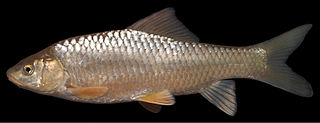 W
WThe Orontes himri is a ray-finned fish species in the family Cyprinidae.
 W
WThe Pacific Sharpnose shark, also known as Rhizoprionodon longurio, often migrates along the Pacific coast of Mexico. They are most commonly caught in the artisanal fishery of Mazatlán. When a large sample of Pacific Sharpnose Sharks were observed scientists concluded that this type of shark was a “viviparous shark of small size which is born at an average length of 31 cm.” Their gestation period is between ten and eleven months. There was found to be no statistical relationship between the number of embryos to the average length. The sex ratio is one to one with the average number of embryos per female being around 7.4.
 W
WPagellus bellottii, the Red pandora, is a species of fish found off the coast of Africa and the Canary Islands, from the western Mediterranean southwards to Angola. A demersal feeder, they can generally be found at depths of 10 m to 50 m. Individuals can reach 42 cm, but average 25 cm. It is a protogynic hermaphrodite; individuals start out life as females, and some become male later on.
 W
WThe panamic green moray eel is a large moray eel in the Pacific. Common names also include chestnut moray eel.
 W
WThe pelican eel is a deep-sea eel rarely seen by humans, though it is occasionally caught in fishing nets. It is the only known member of the genus Eurypharynx and the family Eurypharyngidae. It belongs to the "saccopharyngiforms", members of which were historically placed in their own order, but are now considered true eels in the order Anguilliformes. The pelican eel has been described by many synonyms, yet nobody has been able to demonstrate that more than one species of pelican eel exists. It is also referred to as the gulper eel, pelican gulper, and umbrella-mouth gulper. The specific epithet pelecanoides refers to the pelican, as the fish's large mouth is reminiscent of that of the pelican.
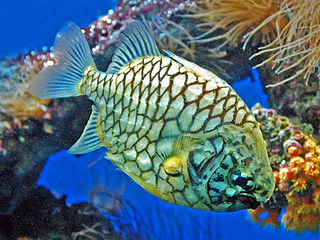 W
WThe pineapplefish is a species of fish in the family Monocentridae, and the sole member of its genus. It is also known as the knightfish or the coat-of-mail fish, due to the armor-like scales covering its body, and the port-and-starboard light fish, as it has a pair of bioluminescent organs that are reminiscent of navigation lights on ships. Its specific epithet is from the Latin gloria and maris, meaning "glory of the sea".
 W
WPtychochromis grandidieri is a species of fish in the family Cichlidae endemic to river basins along a large part of the eastern coast of Madagascar, although it has been recorded as far as 100 km (62 mi) inland. Uniquely in the genus Ptychochromis, this species also occurs in brackish water. It reaches 21.3 cm (8.4 in) in standard length. It shares a large part of its range with a cichlid from another genus, Paretroplus polyactis. The specific name honours Alfred Grandidier (1836-1921), the French naturalist and explorer who, with Henri Joseph Léon Humblot (1852-1914), collected the type.
 W
WThe red pike conger is an eel in the family Muraenesocidae. It was described by David Starr Jordan and Charles Henry Gilbert in 1882, originally under the genus Muraenesox. It is a marine, tropical eel which is known from the eastern central and southeastern Pacific Ocean, including Mexico, Ecuador, Colombia, Costa Rica, Guatemala, El Salvador, Honduras, Panama, Peru, and Nicaragua. It dwells at a depth range of 10 to 100 metres, and inhabits sediments of sand and mud. Males can reach a maximum total length of 202 centimetres (80 in); the maximum recorded weight is 11.0 kilograms (24.3 lb).
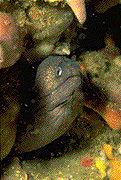 W
WMuraena retifera is a moray eel with pharyngeal jaws. It is part of the genus Muraena.
 W
WThe scaly sand darter is a species of freshwater ray-finned fish, a darter from the subfamily Etheostomatinae, part of the family Percidae, which also contains the perches, ruffes and pikeperches. It is endemic to the southeastern United States. It is found in the coastal plain area of the Mississippi River basin, typically in medium-sized streams with slow currents over sandy substrates where it feeds on midge larvae and other small invertebrates. The slender body is semi-translucent, yellowish with a dozen or so dark bars. This fish has a wide range and is relatively common, and the International Union for Conservation of Nature lists it as a "least-concern species".
 W
WThe serpae tetra, also known as jewel tetra or callistus tetra, is a species of tropical freshwater fish of the characin family of order Characiformes. It is native to the Amazon River drainage in Brazil, Peru, Paraguay, Bolivia and northern Argentina. The fish can be found in slow moving or still backwater including, ponds, small lakes, and streams. In the wild, it forms aggregations around vegetation and tree roots, and thrives when the water temperature is 22-27 °C (72-82 °F).
 W
WThe sicklefin smooth-hound is a houndshark of the family Triakidae. Even some species look similar to Carcharhinus family, mustelus second dorsal fin is much bigger. It is found on the continental shelves of the eastern Pacific, between latitudes 33° N and 7° N. The difference between sharptooth smooth-hound and mustelus lunulatus, is that the lunulatus second dorsal fin origin far in advance of the anal fin. It can reach a length of up to 1.7 m. The reproduction of this shark is ovoviviparous.
 W
WThe southern puffer, Sphoeroides nephelus, is a species in the family Tetraodontidae, or pufferfishes. It is found in the Caribbean Sea, and possibly further south on the coast of Brazil.
 W
WTylosurus fodiator, the Mexican needlefish, is a species of needlefish from the family Belonidae which is found only in the eastern Pacific, from the Gulf of California south to Ecuador including the Galapagos, Cocos and Malpelo Islands. It was previously considered to be a subspecies of the houndfish but is now regarded as valid species. This species is normally encountered close to the coast but can be found in offshore waters. It is a predatory species, feeding mainly on small fishes. They lay eggs which adhere to objects in the water by filaments which cover the outer layer of the eggs. This species was described in 1882 by David Starr Jordan and Charles Henry Gilbert with the type locality given as Mazatlán in Sinaloa, western Mexico.
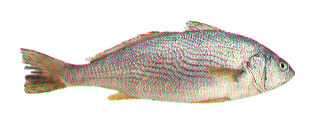 W
WYellowfin croaker is a species of croaker occurring from the Gulf of California, Mexico, to Point Conception, California. They frequent bays, channels, harbors and other nearshore waters over sandy bottoms. These croakers are more abundant along beaches during the summer months and may move to deeper water in winter. There is no set size limit for the yellowfin croaker.
 W
WThe yellowtail reeffish is a species of damselfish in the family Pomacentridae. It is native to the Atlantic Ocean. Occasionally, they are found in the aquarium trade.